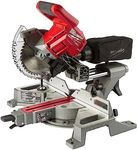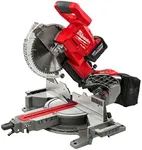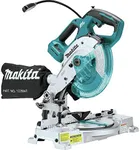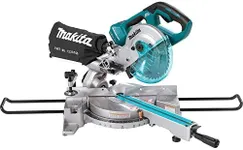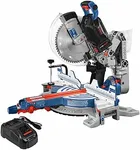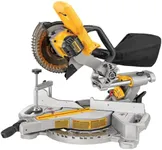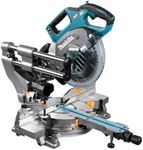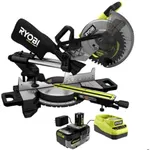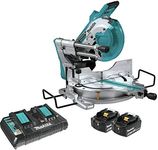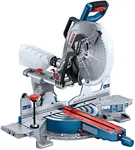Buying Guide for the Best Cordless Miter Saw
Choosing the right cordless miter saw can make a significant difference in your woodworking projects. A cordless miter saw offers the convenience of portability and ease of use without being tethered to a power outlet. When selecting a cordless miter saw, it's important to consider several key specifications to ensure you get the best fit for your needs. Understanding these specs will help you make an informed decision and find a tool that matches your specific requirements.Battery VoltageBattery voltage determines the power output of the cordless miter saw. Higher voltage batteries (such as 18V or 20V) provide more power, which is essential for cutting through thicker and harder materials. If you plan to use the saw for heavy-duty tasks, opt for a higher voltage. For lighter, occasional use, a lower voltage battery may suffice.
Blade SizeThe blade size affects the depth and width of the cut. Common blade sizes for miter saws are 7-1/4 inches, 10 inches, and 12 inches. Larger blades can cut through thicker and wider materials, making them suitable for larger projects. Smaller blades are more manageable and sufficient for smaller, detailed work. Choose a blade size based on the type of projects you typically undertake.
Cutting CapacityCutting capacity refers to the maximum size of the material the saw can cut at various angles. This includes the maximum crosscut, miter cut, and bevel cut capacities. If you work with larger pieces of wood or need to make complex cuts, look for a saw with a higher cutting capacity. For smaller, simpler projects, a lower cutting capacity may be adequate.
Bevel RangeThe bevel range indicates the angles at which the saw can tilt to make bevel cuts. A wider bevel range allows for more versatility in cutting angles. Some saws offer single bevel (tilting in one direction) while others offer dual bevel (tilting in both directions). If you frequently make bevel cuts, a dual bevel saw can save time and effort by reducing the need to reposition the material.
Miter RangeThe miter range specifies the angles at which the saw can pivot to make miter cuts. A wider miter range provides more flexibility for cutting various angles. This is particularly important for tasks like framing, molding, and other detailed work. Consider the typical angles you need to cut and choose a saw with a miter range that accommodates those needs.
Weight and PortabilityThe weight of the cordless miter saw affects its portability. Lighter saws are easier to transport and maneuver, making them ideal for job sites or moving between different work areas. Heavier saws may offer more stability and durability but can be cumbersome to move. Consider how often you need to transport the saw and choose a weight that balances portability with stability.
Dust CollectionDust collection is an important feature for maintaining a clean work environment and ensuring visibility while cutting. Some cordless miter saws come with built-in dust collection systems or ports for attaching a vacuum. Effective dust collection can improve safety and reduce cleanup time. If you work in a confined space or prioritize cleanliness, look for a saw with a good dust collection system.
Additional FeaturesAdditional features such as laser guides, LED lights, and adjustable fences can enhance the usability and precision of the saw. Laser guides and LED lights help improve cutting accuracy by clearly marking the cut line. Adjustable fences provide better support for the material being cut. Consider which additional features will be most beneficial for your specific projects and look for a saw that includes them.
